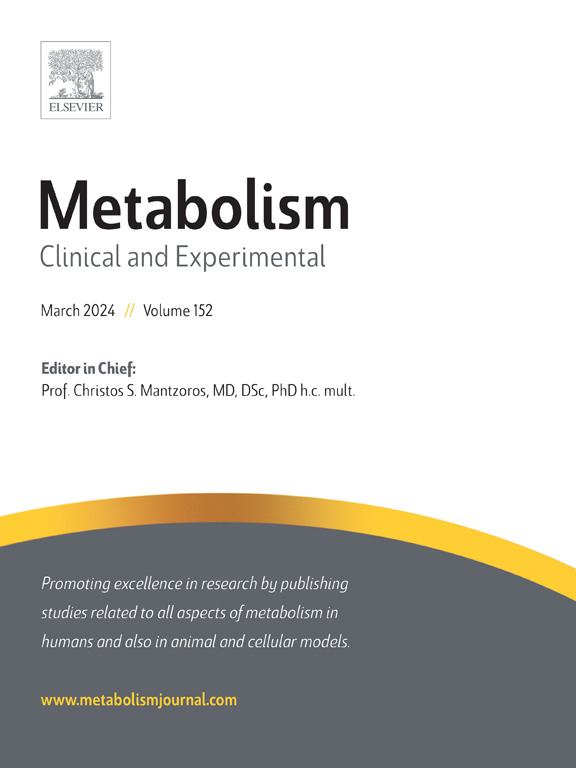WWP1–SHARP1–C/EBPβ positive feedback loop modulates development of metabolic dysfunction–associated steatotic liver disease
IF 10.8
1区 医学
Q1 ENDOCRINOLOGY & METABOLISM
引用次数: 0
Abstract
Background & aims
Metabolic dysfunction–associated steatotic liver disease (MASLD) is a significant global health threat. The molecular mechanisms underlying regulation of MASLD remain largely unknown. This study aimed to investigate the role of the WW domain–containing ubiquitin E3 ligase 1 (WWP1)–enhancer–of–split and hairy–related protein 1 (SHARP1)–C/EBPβ signal loop in MASLD.
Methods
In vivo and in vitro models of MASLD were established applying high–fat diet–fed (HFD) mice and free fatty acid (FFA)–treated hepatocytes. The relationships among SHARP1, WWP1, and C/EBPβ were examined using bioinformatics, immunoprecipitation, immunofluorescence, luciferase assays, chromatin immunoprecipitation. MASLD progression was evaluated based on food intake, energy expenditure, insulin resistance, hepatic steatosis, inflammation and white fat growth.
Results
SHARP1 were significantly reduced in the MASLD livers of mouse and human and in FA–treated hepatocytes. Hepatocyte–specific SHARP1 overexpression significantly inhibited MASLD development in HFD–fed mice. Wild–type SHARP1, but not deficient SHARP1 (SHARP1–K/R and SHARP1–P/A), was ubiquitinated and degraded by the E3 ligase WWP1. Wild–type SHARP1 was not ubiquitinated when WWP1 was deficient (WWP1–C886A, WWP1–C890A, WWP1–ΔWW3). Deficient SHARP1 exhibited better inhibitory activity against MASLD than the wild–type SHARP1. WWP1 overexpression reversed the suppression of MASLD induced by wild–type SHARP1 but did not affect that induced by deficient SHARP1. Deficient WWP1 did not inhibit the wild–type SHARP1–induced MASLD amelioration. Furthermore, in FA–treated hepatocytes, the interaction between SHARP1 and C/EBPβ weakened, resulting in more C/EBPβ binding to the Wwp1 promoter and subsequent WWP1 upregulation. SHARP1 overexpression or WWP1 interference partially blocked the effects of C/EBPβ on MASLD. Hesperidin was identified as a novel WWP1 inhibitor, and it significantly blocked WWP1 overexpression–induced MASLD progression.
Conclusion
The WWP1–SHARP1–C/EBPβ signal loop accelerates MASLD progression. This study provides novel insights into novel biomarkers and treatment approaches for MASLD.

WWP1-SHARP1-C /EBPβ正反馈回路调节代谢功能障碍相关脂肪变性肝病的发展
背景,代谢功能障碍相关的脂肪变性肝病(MASLD)是一个重大的全球健康威胁。MASLD调控的分子机制在很大程度上仍然未知。本研究旨在探讨WW结构域含泛素E3连接酶1 (WWP1) -分裂增强子和毛发相关蛋白1 (SHARP1) -C /EBPβ信号环在MASLD中的作用。方法采用高脂日粮(HFD)小鼠和游离脂肪酸(FFA)处理的肝细胞建立MASLD的体内和体外模型。采用生物信息学、免疫沉淀、免疫荧光、荧光素酶测定、染色质免疫沉淀等方法检测SHARP1、WWP1和C/EBPβ之间的关系。根据食物摄入、能量消耗、胰岛素抵抗、肝脂肪变性、炎症和白色脂肪生长来评估MASLD的进展。结果小鼠和人MASLD肝脏及fa处理的肝细胞中sharp1显著降低。肝细胞特异性SHARP1过表达显著抑制hfd喂养小鼠的MASLD发展。野生型SHARP1,而非缺陷型SHARP1 (SHARP1 - k /R和SHARP1 - p /A),被E3连接酶WWP1泛素化和降解。WWP1缺乏时,野生型SHARP1不泛素化(WWP1 - c886a, WWP1 - c890a, WWP1 -ΔWW3)。与野生型SHARP1相比,SHARP1缺陷型对MASLD表现出更好的抑制活性。WWP1过表达逆转了野生型SHARP1诱导的MASLD抑制,但不影响SHARP1缺陷诱导的MASLD抑制。缺乏WWP1并不会抑制野生型sharp1诱导的MASLD改善。此外,在fa处理的肝细胞中,SHARP1和C/EBPβ之间的相互作用减弱,导致更多的C/EBPβ结合到Wwp1启动子上,随后Wwp1上调。SHARP1过表达或WWP1干扰部分阻断了C/EBPβ对MASLD的作用。橙皮苷是一种新型的WWP1抑制剂,可显著阻断WWP1过表达诱导的MASLD进展。结论WWP1-SHARP1-C /EBPβ信号环加速MASLD的进展。这项研究为MASLD的新生物标志物和治疗方法提供了新的见解。
本文章由计算机程序翻译,如有差异,请以英文原文为准。
求助全文
约1分钟内获得全文
求助全文
来源期刊

Metabolism: clinical and experimental
医学-内分泌学与代谢
CiteScore
18.90
自引率
3.10%
发文量
310
审稿时长
16 days
期刊介绍:
Metabolism upholds research excellence by disseminating high-quality original research, reviews, editorials, and commentaries covering all facets of human metabolism.
Consideration for publication in Metabolism extends to studies in humans, animal, and cellular models, with a particular emphasis on work demonstrating strong translational potential.
The journal addresses a range of topics, including:
- Energy Expenditure and Obesity
- Metabolic Syndrome, Prediabetes, and Diabetes
- Nutrition, Exercise, and the Environment
- Genetics and Genomics, Proteomics, and Metabolomics
- Carbohydrate, Lipid, and Protein Metabolism
- Endocrinology and Hypertension
- Mineral and Bone Metabolism
- Cardiovascular Diseases and Malignancies
- Inflammation in metabolism and immunometabolism
 求助内容:
求助内容: 应助结果提醒方式:
应助结果提醒方式:


